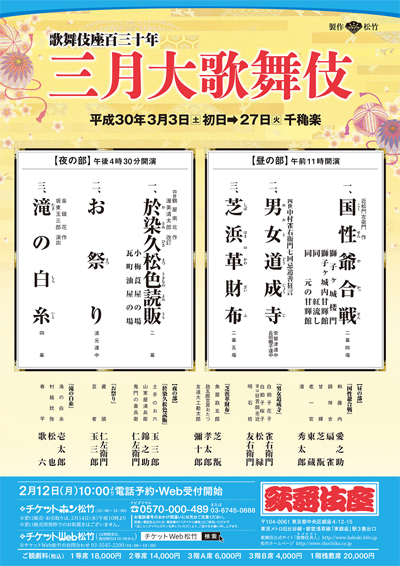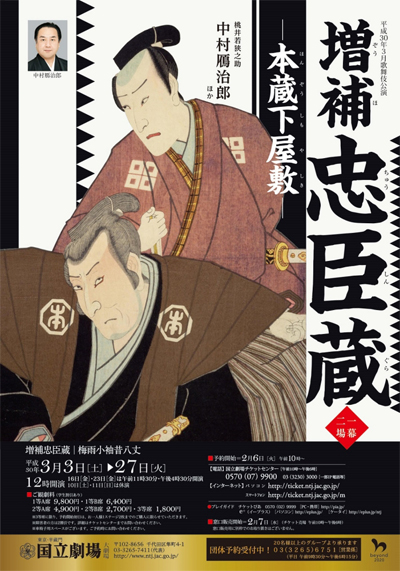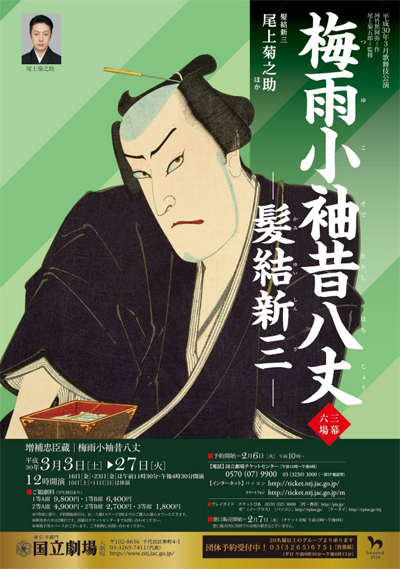| MARCH 2018 |
|
4 shows in T˘ky˘ (Kabukiza, National Theatre) and 2 tours (Shungy˘ Special Tour, Ichikawa Ebiz˘ Special Tour)!
|
| Kabukiza (T˘ky˘) |  |
| Dates | 3 ~ 27 March 2018 Sangatsu ďkabuki March Grand Kabuki |
| MatinÚe | |
| Evening |
Osome Hisamatsu Ukina no Yomiuri Taki no Shiraito |
| Casting |
Living National Treasure Band˘ Tamasabur˘, Living National Treasure Kataoka Nizaemon, Living National Treasure Nakamura T˘z˘, Nakamura Shikan, Nakamura Jakuemon, Nakamura Senjaku, Kataoka Ainosuke, Kataoka Hidetar˘, Onoe Sh˘roku, Band˘ Yajűr˘, Kataoka Takatar˘, Nakamura Kazutar˘, Nakamura Kinnosuke, ďtani Tomoemon, Onoe Matsuya, Nakamura Karoku |
| Comments |
The two stars of these March Grand Kabuki performances are the goruden konbi Living National Treasures Band˘ Tamasabur˘ and Kataoka Nizaemon, who perform together in two important scenes from Tsuruya Nanboku IV's masterpiece "Osome Hisamatsu Ukina no Yomiuri" and the dance "Omatsuri". The Kabukiza also commemorates the 6th anniversary (7th memorial service) of the passing away of late Nakamura Jakuemon IV with his son Nakamura Jakuemon performing, along with Onoe Sh˘roku, in the dance "Meoto D˘j˘ji".
|
 |
| National Theatre (T˘ky˘) |
| Dates | 3 ~ 27 March 2018 |
| Program | |
| Casting |
Nakamura Ganjir˘, Onoe Kikunosuke, Kataoka Kamez˘, Ichikawa Danz˘, Nakamura Baishi, Kawarasaki Gonjűr˘, Ichimura Manjir˘, Ichimura Kitsutar˘, Nakamura Mantar˘ |
| Comments |
The usual March Kabuki performances at the National Theatre:
|
 |
 |
| Dates | 5 ~ 6 March 2018 Baish˘kai |
| Program |
Otokomai |
| Casting | |
| Comments |
1st edition of the Baish˘kai, a gala program which stars Nakamura Shinobu and Ichikawa Emino. |
| Shungy˘ Special Tour | |
| Dates | 17 March ~ 5 April 2018 Shungy˘ Tokubetsu K˘en The Dawn of Spring Special Performances |
| Program |
Geidan Urashima |
| Casting |
Nakamura Kankur˘, Nakamura Shichinosuke, Nakamura Tsurumatsu |
| Comments |
The Spring Tour of the Nakamuraya guild with performances in 12 cities. The first item (geidan) in this program is a talk.
|
| Ichikawa Ebiz˘ Special Tour | |
| Dates | 1 March ~ 7 April 2018 Ichikawa Ebiz˘ Tokubetsu K˘en Ichikawa Ebiz˘ Special Performances |
| Program | |
| Casting |
Ichikawa Ebiz˘, Kataoka Ichiz˘, Ichimura Kakitsu, Ichikawa Kudanji, ďtani Hiromatsu, Katayama Kur˘emon, Kanze Yoshimasa, Miroku Tadashi, Shigeyama Ippei, Ichikawa Botan |
| Comments |
The Spring Tour of Ichikawa Ebiz˘ with performances in 23 cities. A special program mixing Kabuki, N˘ and Opera. The heir of the Naritaya guild performs in a special version of "Genji Monogatari", featuring the N˘ actors Katayama Kur˘emon X and Kanze Yoshimasa, and the Opera Tenor/Countertenor Miroku Tadashi. The script for this version of "Genji Monogatari" focuses on the story from Oborozukiyo to Suma/Akashi.
|
|
|||
| Dates | 24 ~ 27 March 2018 Wakate Buy˘ K˘en SUGATA Young Dancers Performances SUGATA |
||
| Program | |||
| Casting | |||
| Comments |
A gala program called SUGATA (appearance) for the young actors Nakamura Takanosuke and Nakamura Tamatar˘. |
||
|
|
| Contact | Main | Top | Updates | Actors | Plays | Playwrights | Programs | Links | FAQ | Glossary | Chronology | Illustrations | Prints | Characters | Derivatives | Theaters | Coming soon | News |
